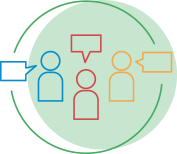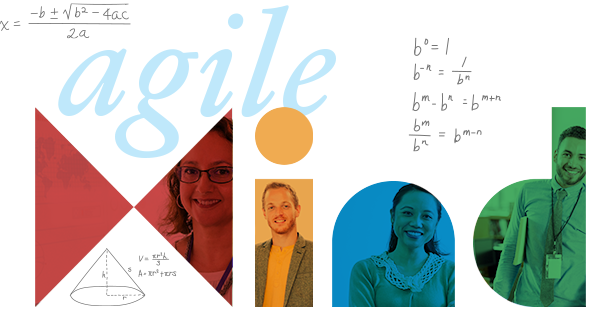Engaging English Language Learners in Mainstream Classrooms
In classrooms throughout the country, we hear of the challenges associated with engaging English Language Learners (ELLs) in mainstream math and science learning. Research shows that ELLs in mainstream classrooms tend to talk and participate less than their peers (Zhang et al., 2016). Curriculum supports like those in Agile Mind can help—such as real-world contexts, manipulatives, use of multiple representations of concepts, and guidance for teachers to create meaningful opportunities for students to listen, speak, read, and write about new content. But the districts and schools that best serve the needs of their language learners do so by considering them from the outset and systematically structuring classroom communication in ways that promote classroom talk for all students, including ELLs.
Build a Team Early
Creating an inclusive classroom community begins not by doing math, but by building a team. The first weeks of school can be dedicated to establishing a classroom culture in which everyone is recognized as a valuable member and is expected to participate fully and contribute to the team. First-week team building, with activities such as the well-known human knot, no-hands cup stacking challenge, and helium sticks, allows students to learn about each other, open lines of communication, and practice working with all students–not just established friends or fellow ELLs. These fun and often-humorous activities enable students to build rapport and trust, and give them repeated opportunities to fail, work as a team, think divergently, and try different approaches to solve challenges.
Normalize Mistakes

Teachers can establish a culture of “failing forward” in the first month of school by engaging students in experiences that develop their identities as learners who understand the importance of productive persistence and a growth mindset (Dweck, 2008). Agile Mind teachers who engage in our Academic Youth Development and Intensified Programs experience how students can benefit from understanding SEL concepts like motivation, persistence, and the nature of intelligence, and applying them—along with proven problem-solving strategies, routines, and tools—to rigorous experiences in mathematics. In Academic Youth Development, these experiences typically happen over summer or in advisory periods during the school year. In our Intensified programs, students who are seen to be at high risk of failing learn these ideas and skills embedded in a comprehensive, extended-time mathematics curriculum for Algebra I or Integrated Mathematics 1. Through this work, students come to better understand themselves and their learning, including the importance of making mistakes, reflecting on progress, persevering, and trying again. In any classroom, teachers and students can embrace this idea:
Mistakes are expected, respected, and inspected.
Because many ELLs experience language-related embarrassment, anxiety, and fear of making mistakes that can impede their willingness to communicate (Pappamihiel, 2002, 2016), repositioning mistakes as part of successful learning can alleviate these emotions and remove barriers to participation. Mistakes by students in class—either linguistic or mathematical—are valuable and essential to the learning process for everyone, and can be positively reframed as opportunities to “grow your brain.”
Develop Communication Structures & Routines
Beyond conveying that imperfect communication is still important communication, teachers can share other norms and routines to help facilitate classroom discourse. One strategy is to establish voice volume expectations (Level 0 is silence, Level 1 is for small group talk, and Level 2 is public-speaking volume which the entire class can hear); another is to use bring-backs—or call-and-response techniques such as “clap once if you can hear me”—to transition students between activities.
Educators can also teach students how to interact with one another in small groups and engage in standards-based mathematical practices, such as explaining individual and group thought processes, asking questions to other students, creating viable arguments, and critiquing the reasoning of others. Many literacy strategies, such as paired readings and ‘think-alouds,’ provide opportunities for students to have specific roles in the learning process. These roles serve to distribute conversational responsibility across all students as well as to “translate” mathematical language into more student-friendly language.
Some Agile Mind teachers organize their class using a “back and forth” style where students spend the majority of time working in small groups, and frequently come back together as a whole class before returning to groups. This modified think-pair-share is often initiated by the teacher posing a question, then saying, “just think silently for 10 seconds, silent Level 0 [10-second pause]. Okay, go.” This silence gives all students time to both develop initial understanding and prepare to produce language before being expected to speak, rather than creating situations in which English-fluent students contribute quickly while ELLs are still interpreting the question.
Routines like these enable all students to engage in academic talk and to quickly and seamlessly transition between activities. This collective effort reinforces the understanding that everyone is learning something new and together establishing a new set of expected behaviors for the class. In this way, ELLs are not positioned as outsiders who are unfamiliar with the language and culture of the class, but rather as fellow insiders and knowers who understand the local language and customs.
After learning teamwork and communication norms, students can apply these ideas in all their classroom every day. Unlike many activities and strategies that are used in isolated lessons, these routines are deeply embedded in the classroom culture: they are used every day, several times a day – and give structure to student interactions and participation.
Value Divergent Ideas & Voices
 One key strategy to increase the likelihood that more students engage with the whole class can be applied after students have been working in pairs or small groups. Many teachers bring the class back together and do one of two things: they “cold call” on students, or they ask for volunteers to give an immediate response. Instead, the NCTM’s 5 Practices for Orchestrating Productive Mathematics Discussions encourages teachers to “warm call” on students. With this approach, the teacher strategically selects a few students, including ELLs, to present and explain their answer to the whole class, and informs these students of the expectation to share before bringing the class back together. Students can then use the last minute of pair/group work to double check answers and practice language before being asked to speak in front of the whole class. After using a bring-back to transition to whole-class, teachers can strategically sequence sharing by the students who were pre-selected to highlight different approaches to the problem or interesting explanations and debate processes. As teachers pre-select those who will share, they might include one or two students whose answers demonstrate common mistakes, to help clarify misconceptions that other students may share. Finally, teachers should use focusing questions to help students make connections among ideas and strategies. This approach elevates the value of mistakes, the diversity of mathematical expression, and the understanding that every student contributes to the group’s mathematical knowledge.
One key strategy to increase the likelihood that more students engage with the whole class can be applied after students have been working in pairs or small groups. Many teachers bring the class back together and do one of two things: they “cold call” on students, or they ask for volunteers to give an immediate response. Instead, the NCTM’s 5 Practices for Orchestrating Productive Mathematics Discussions encourages teachers to “warm call” on students. With this approach, the teacher strategically selects a few students, including ELLs, to present and explain their answer to the whole class, and informs these students of the expectation to share before bringing the class back together. Students can then use the last minute of pair/group work to double check answers and practice language before being asked to speak in front of the whole class. After using a bring-back to transition to whole-class, teachers can strategically sequence sharing by the students who were pre-selected to highlight different approaches to the problem or interesting explanations and debate processes. As teachers pre-select those who will share, they might include one or two students whose answers demonstrate common mistakes, to help clarify misconceptions that other students may share. Finally, teachers should use focusing questions to help students make connections among ideas and strategies. This approach elevates the value of mistakes, the diversity of mathematical expression, and the understanding that every student contributes to the group’s mathematical knowledge.
Using the classic advice “never say anything a kid can say” (Reinhart, NCTM, 2000) and rejecting perceptions that teachers are the gatekeepers of knowledge, teachers should consider the value of choosing to rarely confirm right answers. Further, teachers can strengthen focus on the mathematical meaning students share and encourage, validate, and preserve ELL voices by avoiding the practice of summarizing or repeating student answers, or recasting ELL speech into “correct” English.
Whole-class time is space for students to explain concepts and ideas to each other, not simply for the first student with a raised hand to state the correct answer for the teacher to confirm and move on. For ELLs specifically, this structure provides time to interpret questions, clear guidance on the mechanics and expectations of group talk, and opportunities to prepare language before being asked to speak in front of the class.
Though some may view routine-based pedagogy as restrictive, these norms and routines serve to empower students by teaching them how to communicate with each other, not what to say. And these structures do not force participation; instead, they reduce ambiguity and anxiety by offering clear guidelines, ensuring students know what to expect and what is expected of them. Further, by participating in every bring-back routine, carrying out small group roles, and explaining ideas to classmates, all students—including ELLs—have the opportunity to be routinely recognized and affirmed as knowledgeable members of the classroom community.
Educators can and do create classrooms where ELLs have the time and space to speak, where their voices are heard, and where they are never excluded, ignored, or left behind. The approaches described here have been successfully used and adapted in middle and high schools across the nation. We believe all students deserve to be heard and valued, and we hope more mainstream teachers will examine their own practices to find ways to consider ELLs in their classroom culture, structures, and everyday routines.
Authored by Andrew Paulsen, Senior Advisor, Agile Mind – June 10, 2021
Authors note: This piece was adapted from an article co-written by the author with Meghan Odsliv Bratkovich, which can be found here: http://newsmanager.commpartners.com/tesolc/issues/2021-04-01/3.html
References
Dweck, C. S. (2008). Mindset: The new psychology of success. Random House.
Hill & Flynn. (2006). Classroom instruction that works with English Language Learners. Alexandra, VA: Association for Supervision and Curriculum Development.
Pappamihiel, N. E. (2002). English as a second language students and English language anxiety: Issues in the mainstream classroom. Research in the Teaching of English, 36, 327–355.
Pappamihiel, N. E. and Lynn, C (2016). Adaptations for English Language Learners: Differentiating between Linguistic and Instructional Accommodations. TESL-EJ, Volume 20, Number 3.
Reinhart, S. C. (2000). Never say anything a kid can say! Mathematics Teaching in the Middle School, NCTM 5, 478–483.
Zhang, J. N., Chunling, N., Munwar, S., Anderson, R. C. (2016). What makes a more proficient discussion group in English language learners’ classrooms? Influence of teacher talk and student backgrounds. Research in the Teaching of English, 51(2), 183–208.



